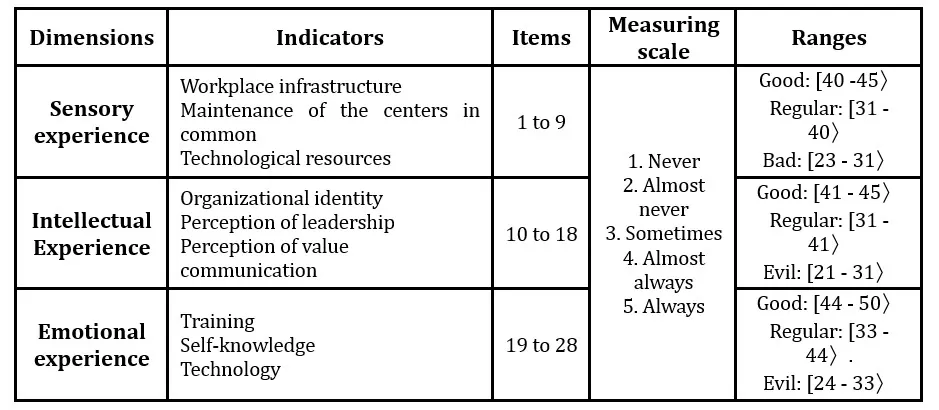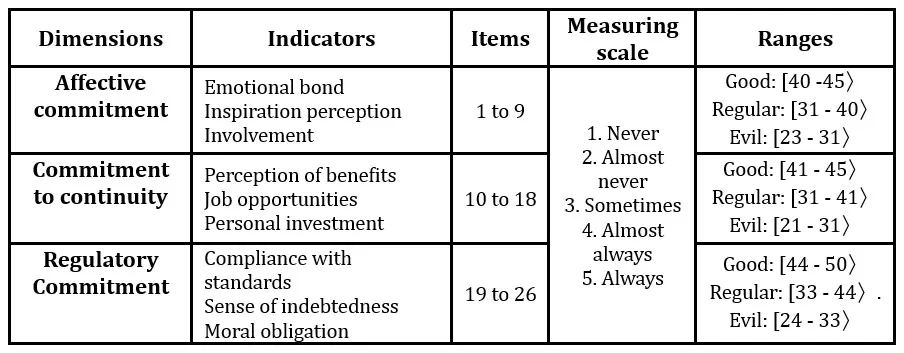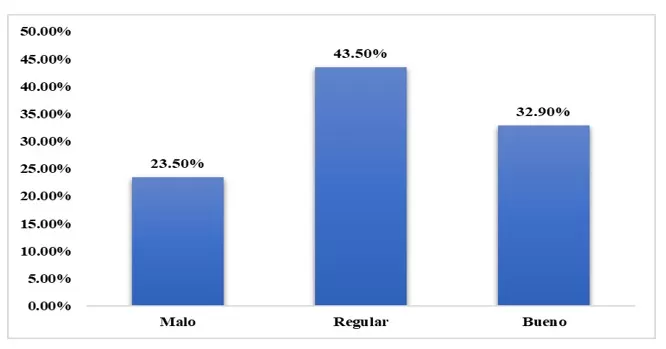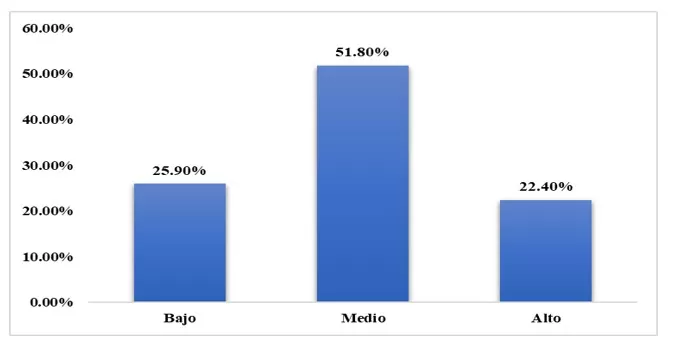Introduction
The current business context is framed by globalization and the rapid advance of technology, specifically those associated with information and communication, requiring organizations to establish far-reaching changes to innovate, be competitive, and achieve maximum levels of efficiency. (Vásconez et al., 2019).In this sense, it is necessary to have the best human talent to face this new reality (Pacherrez and Marrufo, 2019). The human talent must be committed and show high levels of dedication in the execution of their tasks and responsibilities (Upadhyaya and Roy, 2019).
This same global dynamic also requires organizations to satisfy the desires and needs of current and potential workers, since the economic factor is not the only factor that influences to retention or attract the best human talent, the new generations are looking for dynamic work environments, with flexible hours, effective communication, which encourages creativity and innovation and professional development. (ManpowerGroup, 2020). Therefore, when these demands are met, a brand image of the company is built, becoming a competitive advantage (Caballero and López, 2020). Thus, when an organization employs employer branding within its strategies, it can attract and retain the best human talent, based on the company brand it projects, making it a desirable place to work. (Duque et al., 2024).
In Latin America, studies such as the one conducted by ManpowerGroup in 2019 indicate that 45% of the organizations have great difficulty in finding employees with the skills required for their jobs, and 67% of the companies with more than 250 workers have had problems attracting the human talent they require (Alvarez, 2019). Similarly, the study conducted by GoIntegro in 2018 shows that about 70% of the organizations indicate the importance of the commitment of their workers, however, only 36% of these indicated that they develop plans for this purpose (Da Silva, 2018).
In the Peruvian organizational context, the study developed by ManpowerGroup showed that 46% of the companies have difficulties in filling their vacancies, so 56% have tended to carry out personnel development plans to be able to fill such vacancies (Gestión, 2018). Regarding organizational commitment, 87% of the managers indicated that it is urgent to implement strategies aimed at mitigating the low level of identification manifested by workers. Similarly, 12% of the companies develop programs to achieve workers committed to the organization, but only 7% of these have achieved positive results in terms of identification, commitment, and retention of their collaborators (Gestión, 2015).
Because of the above, the present study proposes a research problem: What is the relationship between employer branding and organizational commitment in a company specializing in technological solutions for means of payment in Miraflores-Lima?
Different empirical studies have analyzed the relationship between employer branding and organizational commitment, as evidenced in the work of Ramírez (2022) the existence of a positive and high association (r= 0.885) and in the work of Ccorisapra (2019) that there is a positive and considerable association (Rho= 0.770), which implies that the greater the use of employer branding, the higher the level of organizational commitment. Similarly, the study by Salvador (2018)showed that there is a direct relationship between the implementation of employer branding strategies, the increase in organizational commitment, and the attraction of new talent.
Other research has studied the incidence of endomarketing concerning organizational commitment, obtaining as a result of the study by Flores et al. (2022) a significant influence of endomarketing strategies on the generation of organizational commitment in employees. In turn, Moreira (2022) demonstrated in his study that the dimensions of internal marketing influence the organizational commitment of employees, with the internal communication dimension having the greatest impact (β= 0.421).
The attraction and retention of human talent and organizational commitment has also been studied, as demonstrated in the study by Brzovic (2023) that the most attractive factor for attracting candidates that allows their rapid incorporation and permanence in the organization is the existence of pleasant and healthy work environments that promote respect and trust, thus ensuring the full development of their work, which affects the achievement of business objectives, by generating a sense of belonging in employees.
On the other hand, Ames (2022) reported results contrary to those previously mentioned, since he found a low and negative association between talent attraction factors and work commitment (r= -0.042), which shows that working conditions that were initially attractive to employees do not significantly influence their work commitment. Likewise, he found a low and negative association between the elements of talent retention and work commitment (r= -0.173), which indicates that the elements that retain employees in the company do not guarantee their commitment to the institution or the job.
Brand management has been used successfully for more than seven decades to build the brand reputation of organizations to foster customer engagement and loyalty. This approach can also be employed to attract, retain, and engage the most valuable employees for the achievement of an organization’s goals (Barrow and Mosley, 2005). Employer branding arises as a derivation of the concept of corporate branding; it constitutes the internal culture that is oriented to the establishment of an image of a good employer. (Aguado and Jiménez, 2017)which is projected internally, generating satisfaction in the employees for being members of the organization, and externally, aimed at people outside the organization and potential candidates.
Among the advantages of employer branding in the business environment, the first is an improvement in the reputation of the organization by attracting more qualified candidates, which implies rigorous selection processes to ensure alignment with the company’s values (Bhatnagar and Srivastava, 2008). It increases employee motivation and productivity by facilitating the communication of needs and objectives, achieving greater commitment thanks to the fair working conditions and intangible benefits offered. It also reduces employee turnover and associated costs, creating a competitive advantage through the retention of valuable, rare, and inimitable talent. (Priem and Butler, 2001). It allows the organization to differentiate itself from its competitors and facilitates adaptation to changes and risks in the environment, consolidating the company as an employer of choice (Armstrong, 2006; Sears, 2006).
Organizational commitment is not only based on the employee’s loyalty to the organization, it implies intense participation and identification with the organization, contributing to the achievement of the established goals (Hellriegel, 2009); generating a desire on the part of the employee to maintain this relationship (Robbins and Judge, 2017). Newstrom (2011) adds that this commitment is manifested in the connection and interest of the worker towards the company, which leads to a conviction in the goals and mission of the organization, and an active willingness to contribute to its achievement and continue the employment relationship.
Employee engagement is associated with characteristics that make employees more productive, profitable, confident, and healthy (Bradley and Wollard, 2009). This has a positive impact on organizations, improving performance and increasing employee retention, while reducing the occurrence of burnout (Brzovic, 2023). According to Stein et al. (2021), three key factors facilitate greater employee engagement: helping employees connect to their work with what matters to them, making work less stressful and more enjoyable, and rewarding them with additional time off rather than monetary incentives.
The general hypothesis of this study could be formulated as follows:
“There is a positive and significant relationship between the employer branding strategy and organizational commitment among employees of a company specialized in technological solutions for payment methods in Miraflores – Lima”.
Materials and Methods
The study was framed within the quantitative approach, which implied the collection of data that were subsequently analyzed and processed by statistical methods, for the obtaining of relevant results (Hernández and Mendoza, 2018). It was classified as basic research, since it contributed to creating new knowledge from the understanding of the elements present in the object under study, according to the appreciation of the researcher. In addition, it was characterized by having a non-experimental – cross-sectional design, since the object of study was observed naturally, allowing its analysis without manipulation of the associated variables (Carbajal et al., 2019).data were collected at a specific and unique moment in time (Cabezas et al., 2018). Finally, it was located as correlational, being the intention to know how the studied variables are related to each other, allowing to describe how the behavior of one variable is related to the behavior of another one.
The population for the study consisted of 85 employees working in the company under study. Meanwhile, we worked with a census sample, since we opted for the totality of subjects that make up the population (Soto, 2018). For the collection of data, the survey was assumed as a technique through which the collection of information from a group of subjects, concerning a specific problem, was achieved (Carrasco, 2019). The associated instrument was the questionnaire, which allowed the representation of the variables studied, providing an adequate level of objectivity, validity, and reliability (Hernández and Mendoza, 2018). Two questionnaires were used in the study, which consisted of a series of questions aimed at measuring the perception of the variables studied, consisting of 28 items for the employer branding variable and 26 items for the organizational commitment variable, both with a five-point Likert response scale.
Table 1. Operationalization table of the employer branding variable

Considering the employer branding variable as set out in Table 1, we seek to understand how through the application of marketing and advertising concepts an organization can be managed as a brand, where consumers are those who could potentially work for it (Borracchia, 2016).
Table 2. Operationalization table of the organizational commitment variable

When considering the variable organizational commitment as shown in Table 2, it refers to a form of psychological bond or attachment between employees and an organization, characterized by the belief and acceptance by individuals of the goals and values declared by the company, making efforts on its behalf and with a high desire to remain as members of this organization (Gonzales et al., 1994).
Once the data collection stage was completed, a database was created using Microsoft Excel and SPSS 26 statistical software. The reliability of each instrument was tested using Cronbach’s alpha test and Pearson’s r test was used to analyze the correlation between the variables of employer branding and organizational commitment.
Results
The reliability analysis of the instruments allowed for verifying high reliability for each variable, reporting a value of α=0.967 for the employer branding variable and a value of α=0.925 for the organizational commitment variable, which confirmed the applicability of both instruments. Subsequently, the relational analysis between the variables was carried out, as shown in Table 3.
Table 3. Correlation results between employer branding and organizational commitment
 Table 3 shows a moderate and significant correlation between the two variables (r=0.690; p<0.001), suggesting that the use of employer branding as a business strategy is associated with the level of organizational commitment of workers in a company specializing in technological solutions for payment methods in Miraflores – Lima.
Table 3 shows a moderate and significant correlation between the two variables (r=0.690; p<0.001), suggesting that the use of employer branding as a business strategy is associated with the level of organizational commitment of workers in a company specializing in technological solutions for payment methods in Miraflores – Lima.
Table 4. Analysis of the relationship between employer branding and organizational commitment

Table 4 shows that 14.1% of the employees surveyed perceive a poor relationship between the variables, 30.6% consider it to be fair and 18.8% evaluate it as good, which implies a positive correlation between them.

Figure 1. Percentage analysis of the employer branding variable
Figure 1 shows that 23.50% of the employees perceived employer branding as a bad level, 43.50% rated it as a fair level and 32.90% considered it at a good level. This indicates that, even when employees perceive that the company establishes strategies for the development of workspaces, there are deficiencies in the creation of environments in which they identify with the company, in the communication of organizational values, and the support as a facilitator of the work, hindering their enjoyment at work.

Figure 2. Percentage analysis of the organizational commitment variable
Figure 2 shows that 25.90% of the employees perceived their organizational commitment at a low level, 51.80% considered it at a medium level and 22.40% rated it at a high level. This indicates that employees are reconsidering their long-term relationship with the organization and are evaluating it in terms of the medium or short term, which reflects a lack of involvement and reasons of interest that motivate them to remain part of the organization.
Discussions
According to the results obtained, a moderate and significant relationship between employer branding and the organizational commitment of the workers of a company specializing in technological solutions for means of payment in Miraflores-Lima was demonstrated.
To expand the discussion with the triangulation of results, previous studies, and theoretical foundations, we can integrate three key elements:
Study results: In this study, a positive and moderate correlation (r=0.690, p<0.001) was found between employer branding and organizational commitment among employees of a company specializing in technological solutions for payment methods in Miraflores, Lima. Employees who perceived better employer branding strategies showed a higher level of organizational commitment, suggesting that initiatives projecting an attractive company image also influence workers' identification, motivation, and loyalty.
Triangulation with previous studies: The results are consistent with the findings of previous studies, such as Ramírez (2022) who reported a high association (r=0.885) between these two variables. Similarly, Ccorisapra (2019) found a significant positive correlation (Rho=0.770), reinforcing the idea that effective branding not only improves talent attraction but also increases levels of organizational commitment. In contrast, Ames (2022), in his study, reported a weak negative relationship (r=-0.042) between talent attraction factors and job commitment, suggesting that initially attractive working conditions do not necessarily guarantee long-term commitment.
The convergence of the mentioned studies with the results of the present analysis highlights the importance of contextualizing employer branding based on the characteristics and needs of employees and the organizational environment. While effective branding strategies tend to improve organizational commitment, they must be adapted to the organizational culture and employee profile to achieve the best results.
Theoretical foundations: From a theoretical perspective, the concept of employer branding is based on corporate brand management (Barrow and Mosley, 2005). This approach suggests that, just as companies seek to build customer loyalty through brand strategies, they can also attract and retain top talent through a strong employer brand. According to Aguado and Jiménez (2017), employer branding generates internal satisfaction among employees and externally projects a desirable employer image, which is essential for maintaining a productive and cohesive work environment.
In relation to organizational commitment, Robbins and Judge (2017) argue that it involves deep identification with the organization’s goals and values, generating in employees a desire to actively contribute to organizational achievements and to maintain a prolonged employment relationship. Hellriegel (2009) adds that organizational commitment is not only linked to employee loyalty but also to their active participation in company processes, which increases productivity and reduces turnover.
Final discussion: The positive relationship between employer branding and organizational commitment, supported by both the study results and previous studies, as well as the theoretical foundations, reinforces the idea that an effective employer branding strategy has a significant impact on employee loyalty and dedication. However, it is important to consider that these strategies must be aligned with employee expectations, as suggested by Ames (2022) who shows that initial working conditions do not always guarantee sustained commitment.
Therefore, companies that seek to maximize organizational commitment should not only develop a strong employer brand but also implement long-term talent management policies that promote employee satisfaction and professional growth, which in turn will strengthen their commitment to the organization.
Conclusions
Concerning the objective of the study on the use of employer branding as a business strategy and the perception of the level of organizational commitment of employees of a company specializing in technological solutions for payment methods in Miraflores-Lima, a positive, moderate, and significant association between employer branding and organizational commitment was demonstrated. This finding highlights the relevance of creating and maintaining an employer brand, projecting itself internally within the organization by generating satisfaction in employees for being members of the company, and externally attracting the human talent it requires.
References
-
- Aguado, M., & Jimémez, A. (2017). ‘Companies that leave a mark: Employer branding in a connected society,’ Almuzara.
- Alvarez, P. (2019). ‘Talent shortage, a global problem,’ Cinco Días. https://cincodias.elpais.com/cincodias/2019/01/04/fortunas/1546624234_953459.html
- Ames, R. (2022). ‘Human talent attraction and retention factors and their influence on organizational commitment,’ CUC Economics, 43(1), https://doi.org/10.17981/econcuc.43.1.2022.Org.1
- Arias, J., and Convinos, M. (2021). ‘Research design and methodology,’ Enforques Consulting EIRL.
- Arispe, C., Yangali, J., Guerrero, M., Lozada, O., Acuña, L., and Arellano, C. (2020). ‘Scientific research,’ International University of Ecuador.
- Armstrong, M. (2006). ‘A Handbook of Human Resource Management Practice,’ Kogan Page Publishers.
- Barrow, S., and Mosley, R. (2005). ‘The Employer Brand: Bringing the Best of Brand Management to People at Work,’ John Wiley & Sons.
- Bhatnagar, J., and Srivastava, P. (2008). ‘Strategy for Staffing: Employer Branding & Person Organization Fit,’ Indian Journal of Industrial Relations, 44(1), 35-48. https://www.jstor.org/stable/27768170
- Borracchia, C. (2016). ‘Young people don’t dream companies: Why you should manage your employer brand,’ https://www.academia.edu/35717587/LOS_J%C3%93VENES_NO_SUE%C3%91AN_CON_COMPA%C3%91%C3%8DAS
- Bradley, M., and Wollard, K. (2009). ‘A Historical Perspective of Employee Engagement: An Emerging Definition. In M. Plakhotnik, N. Nielsen, & D. Pane (Eds.),’ Proceedings of the Eighth Annual College of Education & GSN Research Conference (pp. 133-139). http://coeweb.fiu.edu/research_conference/
- Brzovic, J. (2023). ‘Attraction and retention of talent and its influence on organizational commitment: Detection of key variables in disruptive contexts [Master’s Thesis, Universidad del Desarrollo],’ https://repositorio.udd.cl/server/api/core/bitstreams/ff96164e-2f7b-46c4-821a-ddd52298e282/content
- Caballero, M., and López, S. (2020). ‘The Importance of Employer Branding,’ Journal of Business Administration and Management, 0(4), Article 4. https://www.uco.es/docencia_derecho/index.php/RAYDEM/article/view/218. https://www.uco.es/docencia_derecho/index.php/RAYDEM/article/view/218
- Cabezas, E., Naranjo, D., & Torres, J. (2018). ‘Introduction to the methodology of scientific research,’ Editorial Committee of the University of the Armed Forces ESPE.
http://repositorio.espe.edu.ec/jspui/bitstream/21000/15424/1/Introduccion%20a%20la%20Metodologia%20de%20la%20
investigacion%20cientifica.pdf
- Carbajal, Y., Contreras, V., Fuentes, L., Saavedra, J., & Vasquez, A. (2019). ‘Research methodology. Student’s handbook,’ Academic Unit of General Studies USMP.
- Carrasco Díaz, S. (2019). ‘Methodology of scientific research. Methodological guidelines to design and elaborate the research project,’. San marcos EIRL.
- Ccorisapra, F. (2019). ‘Relationship between employer brand and organizational commitment in university teachers in the Arequipa Region, 2019 [Master’s Thesis, Universidad Nacional San Agustin de Arequipa],’ http://repositorio.unsa.edu.pe/handle/UNSA/10506
- Da Silva, T. (2018, February 22). ‘Work engagement and employee “happiness”,’ Forbes Mexico. https://www.forbes.com.mx/compromiso-laboral-y-felicidad-del-colaborador/
- Duque, V. K., Túñez, J., & Mazza, B. (2024). ‘Employer branding its approach in Ibero-America: Trends from a bibliometric analysis,’ Revista Venezolana de Gerencia, 29(105), 141-159. https://dialnet.unirioja.es/servlet/articulo?codigo=9283010
- Flores, C., Placido, R., Valdemar, B., and Ponte, E. (2022). ‘Endomarketing to develop an organizational commitment of the administrative staff of the informal property formalization agency, Chimbote – 2021,’ Ciencia Latina Revista Científica Multidisciplinar, 6(1), 1039-1052. https://doi.org/10.37811/cl_rcm.v6i1.1560
- Gestión (2015). ‘87% of companies consider lack of labor commitment as their main problem TENDENCIAS GESTIÓN,’. Gestión. https://gestion.pe/tendencias/management-empleo/87-empresas-considera-falta-compromiso-laboral-principal-problema-105592-noticia/
- Management (2018). ‘Talent shortage: The difficulty of companies to fill their vacancies,’ Gestión. https://gestion.pe/economia/management-empleo/escasez-talento-dificultad-empresas-cubrir-vacantes-226576-noticia/?ref=gesr
- Gonzales, V., Lloret, S., Ferreres, A., Tomás, I., Espejo, B., and Hernández, A. (1994). ‘The measurement of psychological well-being and other aspects of mental health,’ Ñau Llibres.
- Hellriegel, D. (2009). ‘Organizational behavior,’ (10th ed.). Cengage Learning.
- Hernández-Sampieri, R., & Mendoza, C. (2018). ‘Research methodology: Quantitative, qualitative, and mixed routes,’ McGraw-Hill Interamericana Editores, S.A. de C. V.
- ManpowerGroup (2020). ‘Closing the Skills Gap: What Workers Want,’ https://acortar.link/qKSyGW
- Moreira, N. (2022). ‘La Gestión del Marketing Interno y el Compromiso Organizacional en el Cooperativismo de Ecuador [Doctoral Thesis, Universidad de Córdova],’ http://helvia.uco.es/xmlui/handle/10396/22706
- Newstrom, J. (2011). ‘Human behavior at work,’ (2nd ed.). McGraw Hill.
- Pacherrez Riva, J., and Marrufo Fernández, G. (2020). ‘Modelo de Gestión por Competencias para optimizar el desempeño laboral de los colaboradores de la Municipalidad Provincial de Rioja, 2020,’ Ciencia Latina Revista Científica Multidisciplinar, 4(2), Article 2. https://doi.org/10.37811/cl_rcm.v4i2.184. https://doi.org/10.37811/cl_rcm.v4i2.184.
- Priem, R. L., and Butler, J. E. (2001). ‘Is the Resource-Based “View” a Useful Perspective for Strategic Management Research?,’ Academy of Management Review, 26(1), 22-40. https://doi.org/10.5465/amr.2001.4011928
- Ramírez, A. (2022). ‘La marca empleadora en el compromiso de los colaboradores administrativos de la Universidad Nacional José María Arguedas, Apurímac 2022 [Master’s Thesis, Universidad Cesar Vallejo],’ https://repositorio.ucv.edu.pe/handle/20.500.12692/134057
- Robbins, S. P., & Judge, T. (2017). ‘Ingebook-ORGANIZATIONAL BEHAVIOR 17ED – (Seventeenth),’ https://www.ingebook.com/ib/NPcd/IB_BooksVis?cod_primaria=1000187&codigo_libro=6869
- Salvador, K. (2018). ‘Implementation of employer branding strategies to improve the attraction and retention of human talent through organizational commitment [Master’s Thesis, Universidad de Especialidades Espiritu Santo],’ http://repositorio.uees.edu.ec/handle/123456789/2565
- Sears, D. (2003). ‘Successful talent strategies: Achieving superior business results through market-focused staffing,’
- Sivertzen, A., Nilsen, E., & Olafsen, A. (2013). ‘Employer branding: Employer attractiveness and the use of social media,’ Journal of Product & Brand Management, 22(7), 473-483. https://doi.org/10.1108/JPBM-09-2013-0393
- Soto, E. (2018, August 29). ‘Sampling and sample size for a thesis,’ https://tesisciencia.com/2018/08/29/muestreo-muestra-tesis/
- Stein, D., Hobson, N., Jachimowicz, J., & Whillans, A. (2021, October 13). ‘How companies can improve employee engagement right now,’ Harvard Business Review. https://hbr.org/2021/10/how-companies-can-improve-employee-engagement-right-now
- Upadhyaya, K., & Roy, S. (2021). ‘Self-Regulatory Effects of Performance Management System Consistency on Employee Engagement: A Moderated Mediation Model,’ American Business Review, 24(1). https://doi.org/10.37625/abr.24.1.1-2. https://doi.org/10.37625/abr.24.1.1-2
- Vásconez, V., Vásconez, H., Guerrero, F., & Neira, L. (2019). ‘Organizational culture and its incidence on job performance in governmental public institutions,’ CIENCIAMATRIA, 5(9), Article 9. https://doi.org/10.35381/cm.v5i9.215. https://doi.org/10.35381/cm.v5i9.215








